Mercury COP5 Interventions
Intervention on the trade in mercury
Presented by Yuyun Ismawati, Nexus3 Indonesia
Thank you, Madame President.
IPEN welcomes the analysis of national reports prepared by the Secretariat for this meeting.
As most products and legal manufacturing processes that relied on mercury have been phased out, there is little justification to continue the global mercury trade. Most mercury being traded finds its way intoASGM. We observed the emergence of new mercury-exporting countries that are party to the Minamata Convention.
Therefore, IPEN supports the Draft Resolution on mercury supply, source, and trade. We support the callfor parties to report on all primary mercury mining activities being carried out in their territories, irrespective of their status as formal, informal, or illegal in their following national reports. We also support CRP2 proposed by Canada, Australia, GRULAC, and United State to begin the compilation of mercury compounds for future works.
In addition to adding mercury compound into the next meeting, IPEN invites parties to consider introducing an amendment to Article 3 not to allow the import and export of elemental mercury and cinnabar by 2027,except for environmentally sound disposal. Parties that have already prohibited or banned elemental mercury export could share their lessons learned and barriers to enforcing their regulations.
We learned that in some countries, trade or transactions through e-commerce platforms have not been integrated into the country's statistical trade data. Moreover, many developing countries do not have the capacity and tools to monitor the trade of mercury and mercury compounds in e-commerce platforms and social media. Technical guidance and capacity building are needed to improve national reporting, especially elemental mercury trade that potentially will be used for ASGM.
IPEN also invites delegates to pay attention to the court process and verdicts on confiscated mercury cases, as mercury cannot be destroyed, auctioned, donated, or sold for other purposes under "use allowed" by the treaty.
Lastly, we would like to reiterate that Article 7 on ASGM should not have been listed as "use allowed" in Article 2 (k) of this treaty. Supporting the Bali Declaration to combat the illegal trade of mercury launchedby Indonesia at COP4, IPEN invites delegates to consider amending this article at COP6 and ending mercury trade globally, especially for its use in the ASGM sector.
I thank you, Madam President.
Intervention on Mercury Emissions
Presented by Satish Sinha, Toxics Link India
Thank you, madame President. I am speaking on behalf of IPEN and its participating organization Toxics Link, India.
Emissions into the air are one of the most significant contributors of mercury releases into the environment, affecting the food chain, and human health, hence the need to hasten action on the National Action Plans to reduce and control emissions. Countries only have four years to implement measures to meet their obligation for the existing coal-fired power plants and other point sources listed in the Annex to implement and regulate mercury emissions controls.
Simultaneously, there is also a need for an alternative assessment for new energy production projects to ensure that clean, renewable energy production is prioritised above fossil fuel-based mercury emitting sources.
Furthermore, we observed the trend of using Refuse-Derived Fuel or RDF as co-firing in coal-fired power plants. This is concerning and might increase harmful chemical emissions from the coal-powered plant and interfere with the efforts to strip off mercury from coal power plant’s stacks.
It is also important to mention the need for more studies and data on mercury releases, including from the oil and gas sector since the available data is inadequate.
Countries also need to ensure the implementation of the provisions of BAT and BEP for all sources of emissions to protect public health and the environment.
Thank you, Madam President.
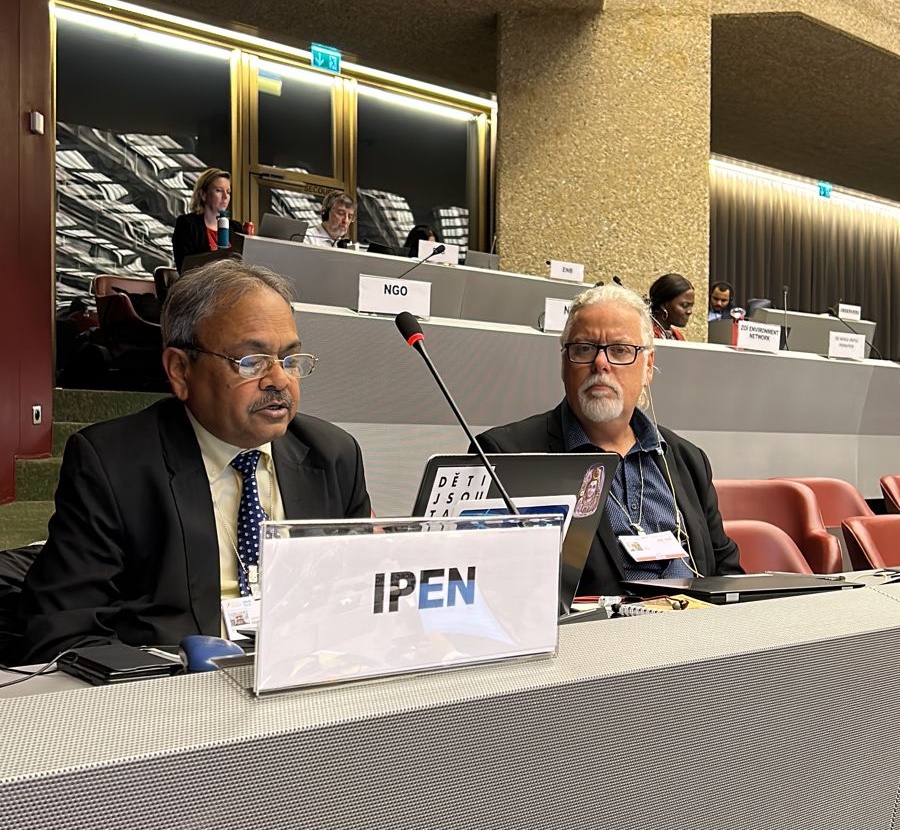
Intervention on effectiveness evaluation
Presented by Semia Ghrabi, AEEFG Tunisia
Thank you Madame President,
We acknowledge the work done by the (Science group) since its third meeting including refining the list of indicators for consideration and possible adoption to be used in the effectiveness evaluation process by COP 5. We consider effectiveness evaluation an important pillar of the convention as it will generate scientific data based on biomonitoring and environmental monitoring to assess the extent to which objectives of the Mercury Treaty are achieved.
IPEN supports the development of the draft list of indicators and has the following suggestions to improve specific indicators on 2-3 and 6:
With regards to indicator 2 on ‘total amount of mercury mined from primary mercury mines’, we have two comments:
This indicator should be more specific since some countries report quantities of cinnabar yet others report elemental mercury which isn’t equivalent. IPEN proposes an elemental mercury-equivalent conversion be provided for parties reporting cinnabar production in tonnes according to the characteristics of cinnabar in the respective countries. Information about the percentage of mercury in cinnabar will assist accuracy in reporting. A more accurate wording for this indicator can be ‘Total elemental mercury extracted from primary mercury cinnabar mines”.
The indicator should cover estimates of legal and illegal primary mining of cinnabar quantities.
With regards to indicator 3- rather than asking if parties have ‘endeavoured’ to identify mercury stocks, we suggest the indicator require:
The number of Parties that have actually identified mercury stocks and record the quantity;
The industry types that are the sources of these stocks and for which the stocks are intended to be used
With regards to indicator 6- the ‘estimated global amount of mercury in tonnes per year, that is traded in accordance with the Convention’, IPEN would like the indicator to reflect:
The quantities of legal trade for elemental mercury, mercury-added products by HS code, mercury compound, and the quantity of mercury directed to mercury-using processes including ASGM. There should be an analysis of mercury quantities trade directed to low and middle- income countries
This indicator should specify mercury traded legally and intended for ASGM use and include an estimate of the illegal quantities used for the same purpose.
Thank you Madame President.
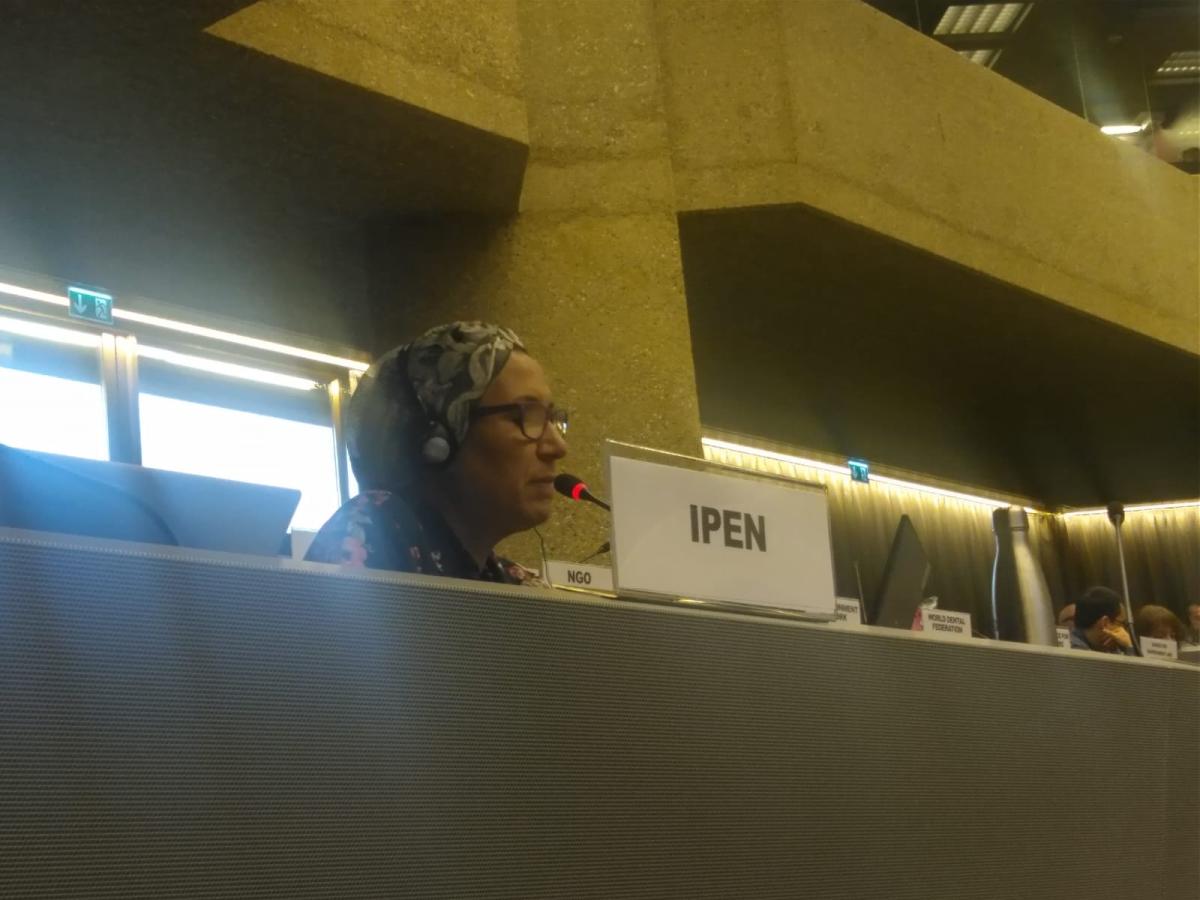
Intervention on ASGM
Presented by Yuyun Ismawati, Nexus3 Indonesia
Thank you, Madame President.
I am speaking on behalf of IPEN, a network of more than 600 public interest NGOs in over 120 countries working for a toxics-free future. Many of us assist ASGM-impacted communities, such as my organization, Nexus3, in Indonesia.
IPEN welcomes efforts and progress that all stakeholders have contributed to the ASGM sector. Ten years after the Minamata Convention entered into force, many countries with ASGM have received information and technical support to substitute mercury with other practices, including the shift to cyanide and other chemicals. However, this shift needs to be supported by strong regulations and measures on chemical safety and environmental protection.
In 2021, the United Nations Human Rights Council Resolution 48/13 acknowledged the right to live in a clean and healthy environment as a fundamental human right. Further, in 2022, the UN Special Rapporteur for Toxic and Human Rights report highlighted the human rights violations, and environmental injustices suffered by indigenous peoples as a result of mercury use in ASGM. Vulnerable local populations, children, women, and people with disabilities suffer the most from mercury pollution. Therefore, IPEN supports the submission of CRP-1 proposed by GRULAC and encourage parties to intensify programs under Article 16 on Health Aspects.
We noted that the guidance on managing contaminated sites has already adopted at COP3. However, many activities that have promoted the replacement of mercury with other chemicals focused on producing gold with little attention to assessing the mercury contamination in the same sites from previous activities.
We observed that environmental and biomonitoring in ASGM areas are still lacking. Data and information regarding mercury-contaminated sites and health monitoring are the main lessons learned from Minamata more than 60 years ago. With the current status of knowledge and technology, mercury pollution and poisoning should be and could be prevented.
Attention also should be paid to addressing technical issues to manage contaminated gold processing equipment, such as ball mills, sluice boxes, gold burning units or kiosks. Parties must prohibit tailings contaminated by mercury for any building components or agricultural purposes. Mercury is used briefly in ASGM but leaves a long-lasting impact on the communities, the ecosystem, and biodiversity.
Lastly, fundamentally, Article 7 on ASGM should not have been listed as "use allowed" in Article 2 (k) of this treaty. IPEN would like to invite delegates to consider amending this article at COP6.
Thank you, Madam President.
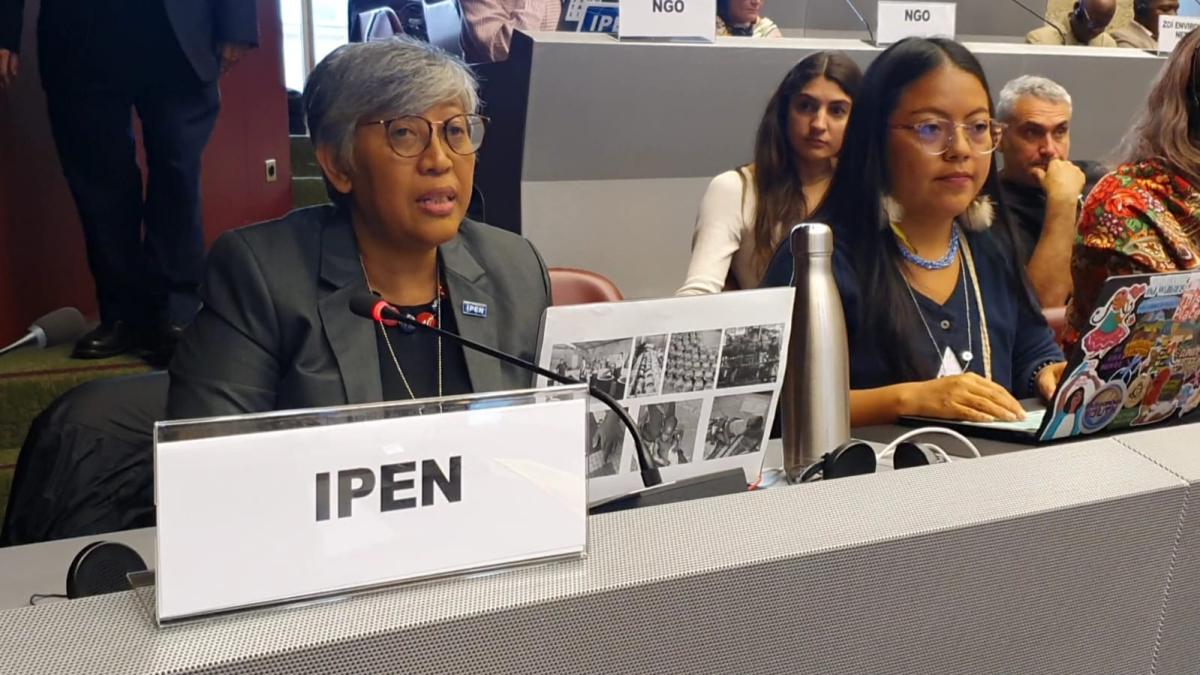
Intervention on mercury waste thresholds
Presented by Anna Odur, AUPWAE, Uganda
Thankyou Madam President
I speak on behalf of IPEN on the matter of establishing total threshold concentrations for mercury waste - category C – wastes that are contaminated with mercury. IPEN has taken part in the expert group on mercury waste since its formation several years ago. The expert group has made considerable progress on several types of mercury waste and its recommendations have mostly been adopted by the COP. However, the group could not reach consensus on a single value for Category C waste. The expert group has proposed 3 values in brackets of 10, 15 and 25mg/kg.
IPEN supports the strictest possible level that is practical to apply to ensure that human exposure is reduced, as much mercury waste as possible is captured within the definition and environmental impact is minimised. The majority of experts on the group supported values in the lower range while only 4 experts supported the high level of 25 mg/kg. Some members were concerned about analytical capacity for the lower proposed levels but screening devices can now confidently measure mercury in the 5-10 mg/kg range.
IPEN supports the adoption of the lowest possible level between 1 and 10 mg/kg and several countries already use thresholds in this range. Under no circumstances should a level be adopted that exceeds 10 mg/kg. It will simply not be protective of human health and the environment and will create a licence to pollute for certain industries. 10 mg/kg is still a relatively high level and, if adopted, IPEN suggests it should be reviewed by the COP within 3 years to establish if it is sufficiently protective of human health and the environment.
Thank you.
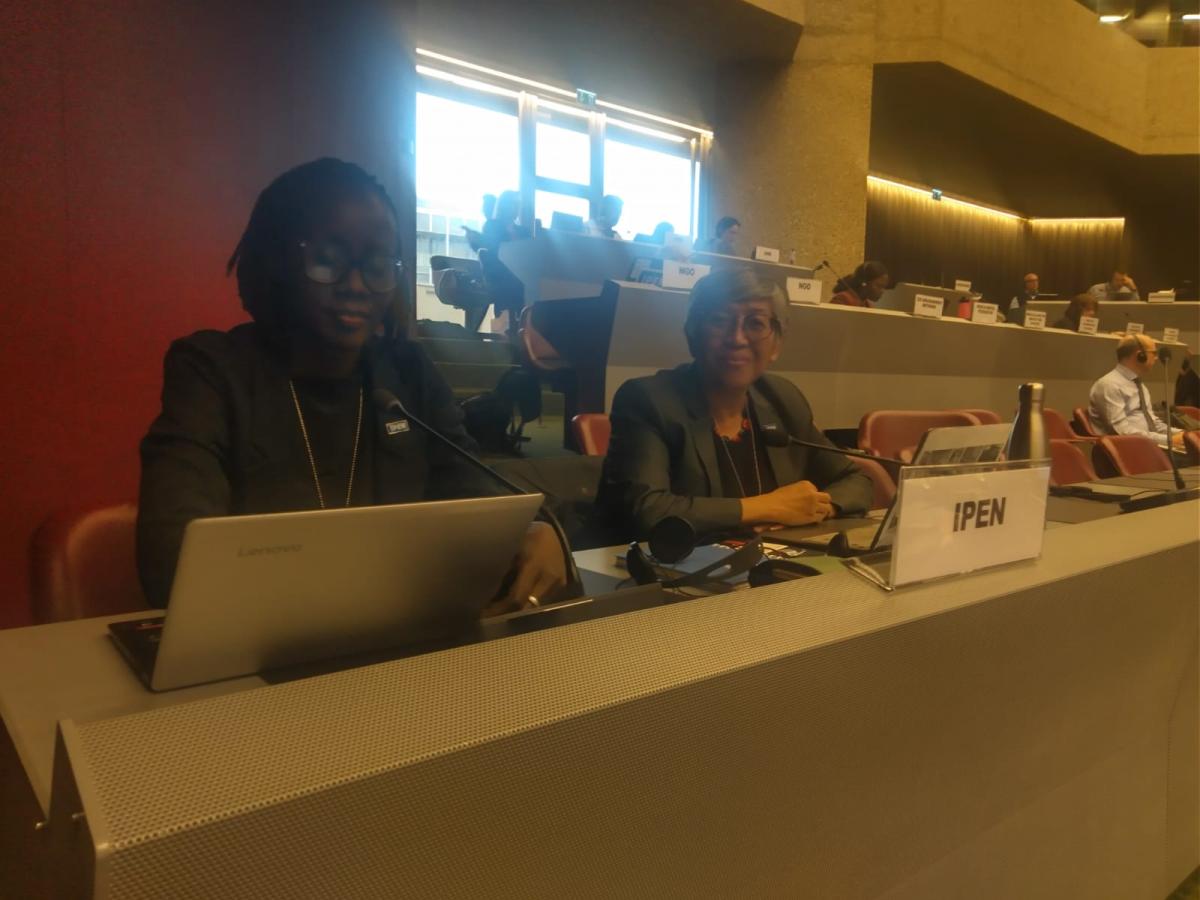
Intervention on Mercury-added products and manufacturing processes in which mercury or mercury compounds are used: amendment to annexes A and B, and consideration of the feasibility of mercury-free alternatives for manufacturing processes listed in annex B (Agenda item 4)
Presented by María Cárcamo, RAPAL Uruguay
Thank you, Madame President.
IPEN supports the statement made by the World Alliance for Mercury-Free Dentistry in support of the African amendment to eliminate dental amalgam.
IPEN also supports the proposed amendment to Annex A that will ban all cosmetics containing any amount of mercury and promote effective measures at the national level that will enforce the ban, stop the marketing of mercury-added cosmetics and reduce public demand for such poisonous products.
Thank you, Madame President.
Intervention on National Reporting
Presented by Leslie Adogame, SRADev Nigeria
IPEN would like to thank all the parties that have provided and submitted their reports in compliance with article 21 of the Convention. Based on the secretariat’s compilation, this translates 95% response rate which is very positive as reporting shows the efforts and commitments by parties to implement the convention.
IPEN would urge the parties that have not complied with the reporting obligation to do so.
IPEN also commends the effort by the secretariat to support the parties to comply with their reporting obligations. On the findings and observations made by the secretariat, we have the following comments.
In particular to the ASGM questions, we would like to make the following recommendations to improve and enhance the accuracy of the information being collected by parties.
- More attention and effort needs to be made by parties to accurately estimate baseline levels of mercury use in ASGM - particularly in the informal sector as the uncertainty factors are currently so high that it will negatively impact effectiveness evaluation for the convention.
- The COP should consider the provision to Parties of additional detailed guidance for the estimation of baseline data on mercury use by the informal sector in ASGM in countries where the activity is significant.
- The guidance on ASGM NAP reporting should be reviewed to ensure that uncertainty factors associated with the informal sector are reflected in baseline estimate methodologies as well as in trend estimates.
- Uncertainty in baseline mercury estimates needs to be reported by Parties to evaluate whether target metrics are being met or whether the baseline is failing to account for diversity in ASGM operations.
- We encourage parties to report on all primary mercury mining activities being carried out in their territories, irrespective of their status as formal, informal or illegal, in their following national reports.
- Last, but not least, we observed that environmental and biomonitoring in ASGM areas are still lacking. We believe such data needs to be involved in national reports. Attention also should be paid to reporting on contaminated gold processing equipment, such as ball mills, sluice boxes, gold burning units or kiosks.
Thank you.
Intervention on Gender
Presented by Siddika Sultana, ESDO Bangladesh
Thank you, Madam President.
I am speaking on behalf of IPEN and its participating organization ESDO, Bangladesh
To address the continuous global mercury crisis emanating from Skin Lightening Products, we support the proposed amendment by the African Region to strengthen the existing provisions within the Convention. These products are mainly used by women and girls and therefore this issue is highly relevant to gender.
First, concerning amending Annex A, Part I, the amendment proposes to replace the existing ban on the manufacture, import, and export of cosmetics “over one ppm mercury” with prohibiting “mercury-added” cosmetics, starting in 2025.
By eliminating the mercury threshold, Parties can more effectively conduct market surveillance by utilizing simple, cost-effective handheld testing devices that preclude the need for lab testing.
Second, concerning amending Annex A, Part II, proposed measures include the following:
- Setting national objectives to phase out sales and offering sales is necessary. - Coordinating and collaborating on phase-out initiatives inter-ministerially bilaterally and/or regionally.
- Raising public awareness about the hazards of SLP use among physicians, dermatologists, beauty centers, as well as consumers and family members.
Above all, COP-5 should initiate activities to “evaluate whether the trade in specific mercury compounds compromises the objective of this Convention and considers whether specific mercury compounds” should be subject to trade restrictions, following Article 3, Paragraph 13 of the Convention.
Along with this, IPEN and ESDO support the amendment in Annex A for dental amalgam, which is phasing out the use of dental amalgam by 2030, discourage use in pregnant women and children and the overall phase out dental amalgam from 2023 that is already enforced. We believe endorsing this amendment is achievable, as they can be implemented without compromising dental care requirements, given the global availability, efficacy, and affordability of mercury-free alternatives.
The first step is to assess the global supply, trade, and use of mercury compounds. IPEN and ESDO support the Gender Action Plan!
I thank you, Madam President.
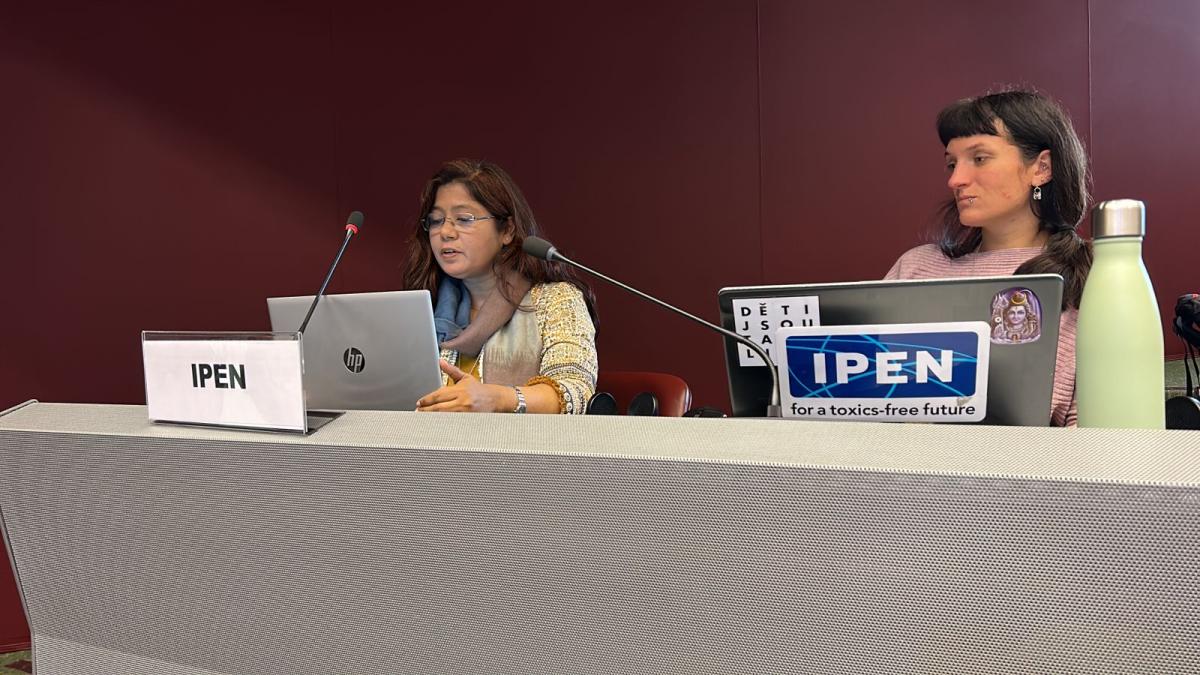
Intervention on Mercury and Kunming-Montreal Global Biodiversity Framework
Presented by Yuyun Ismawati, Nexus3 Indonesia
Thank you, Madame President
Thank you to the Secretariat for preparing the document.
Many IPEN participating organisations are located in biodiversity-rich and sensitive ecosystem countries. Therefore, IPEN supports the recommendation proposed in the Draft Resolution on Mercury and the Kunming-Montreal Global Biodiversity Framework.
Once mercury is released into the atmosphere, mercury’s transport and fate are complex as it cycles between media, with legacy mercury continuing to cycle for decades to centuries.
Promoting the integration of mercury- and biodiversity-related priorities complements the implementation of the Minamata Convention. The Minamata Convention and the Kunming-Montreal Global Biodiversity Framework have the potential to be mutually supportive and generate co-benefits. These co-benefits could be achieved by includingmercury in the “headline indicators” of Target 7 and pollution caused by mercury after nitrogen and pesticides.
Mainstreaming biodiversity and mercury control measures can be done to integrate them into a coherent policy and implementation of the Minamata Convention in the country’s NIP (national implementation plan) or ASGM NAP.
Moreover, monitoring the impact of mercury on biodiversity and ecosystem services needs to be strengthened, especially by sharing data and information related to biota and abiota. It is imperative that Prior and Informed Consent procedures must be upheld when engaging Indigenous Peoples.
Capacity building is needed to assist biodiversity-rich countries in mapping mercury risk from multiple inputs and ecosystem sensitivity that reflect how much available mercury will be converted into its more toxic and bioavailable form.
The Minamata tragedy more than 60 years ago taught us that restoring degraded land and water bodies from mercury pollution will be a challenging task for every country, especially developing countries. The costs to our biodiversity and ecosystem restoration show a clear message about the price of mercury pollution, especially from ASGM. More research and knowledge development are needed, including exploring traditional and indigenous knowledge to find locally-based solutions.
Thank you, Madame President.
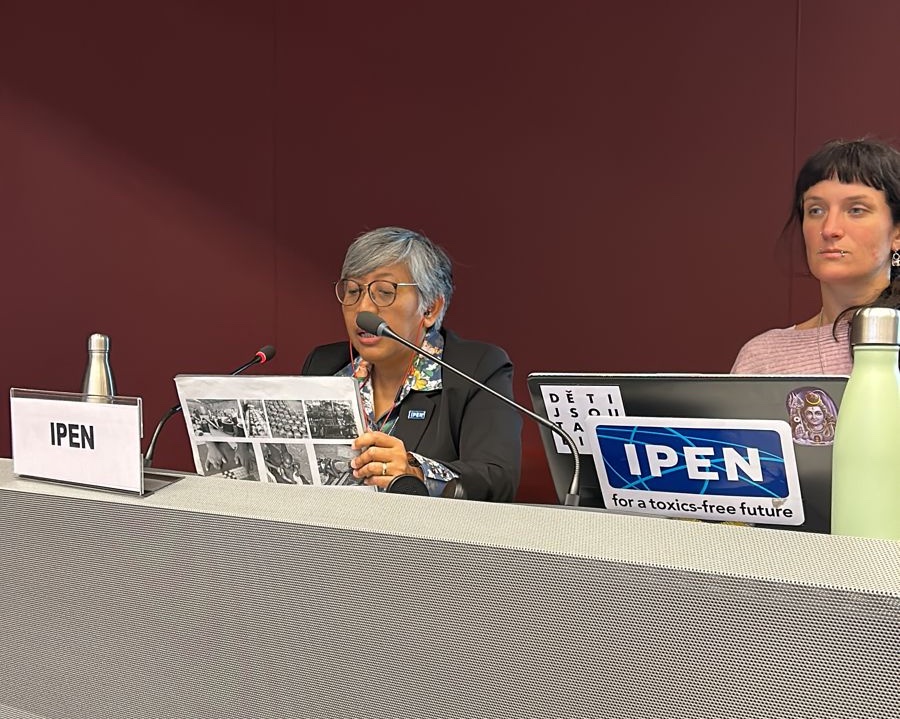
Thank you, Madame President.
IPEN appreciates the work done by the technical expert group on mercury releases on the development of the draft guidance document on best available techniques and best environmental practices to control releases from relevant sources. The guidance is crucial to further prevent or reduce human exposure and environmental contamination by mercury. Therefore, we encourage Parties to adopt the guidance at this COP.
However, we regret that information about some relevant point sources of mercury into land and water are missing in the document, in particular with relation to shipping, cement or waste incineration industries.
Specifically, the guidance document is lacking appropriate information about releases of mercury from secondary use of incineration bottom ash, in particular when bottom ash is used as construction material, soil amendment or other agricultural application, despite direct application of such mercury-contaminated material on the surface of land/ into soil. Similarly, the document also neglects releases from shipbreaking despite the potential direct mercury leaking into water. The information on releases from mercury based pesticides or from mercury contaminated sites are also missing or are insufficient in the document.
To conclude, IPEN truly appreciates the work by the technical group and finds the existing draft document very useful and critical for reducing polluting mercury releases. Nevertheless, we are using this opportunity to share our concerns and alert Parties of the Minamata Convention that the lack of information in the document may negatively affect the health of impacted communities, who deserve protection through the Treaty provisions.
Thank you, Madame President.
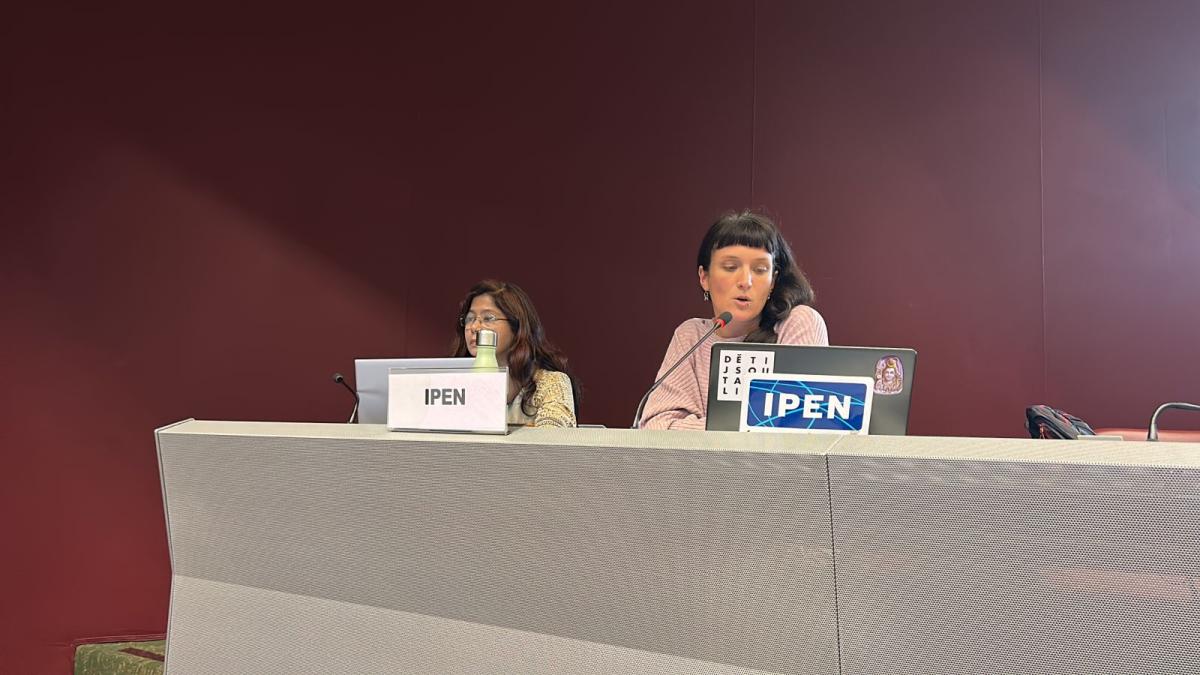
Thank you, Madame President,
IPEN supports the secretariat to continue and to enhance further cooperation and cooperation with the World Health Organization and the ILO to support parties’ efforts to implement health-related aspects of the Convention, including through the use of relevant World Health Organization and the ILO guidance.
Health guidance to protect workers' health in sectors other than ASGM, such as the coal industry, cement industry, shipbreaking industry, extractive industry, and dentist workers are needed.
Article 16 on Health Aspects stipulates that Parties are encouraged to promote the development and implementation of strategies and programs to identify and protect populations at risk, especially vulnerable populations. Further, parties are encouraged to promote appropriate healthcare services for prevention, treatment, and care for populations and workers affected by exposure to mercury.
Parties must conduct health risk assessments and design programs to train their healthcare workers to identify mercury poisoning and develop programs to treat and care for impacted communities and workers.
Further, Article 17 encourages parties to facilitate information exchange concerning health impacts associated with mercury exposure. This information exchange could be done through international cooperation. Progress on medical treatment of mercury poisoning, acute or chronic, must be shared/exchanged, and this has not occurred significantly to date.
Thank you, Madame President.
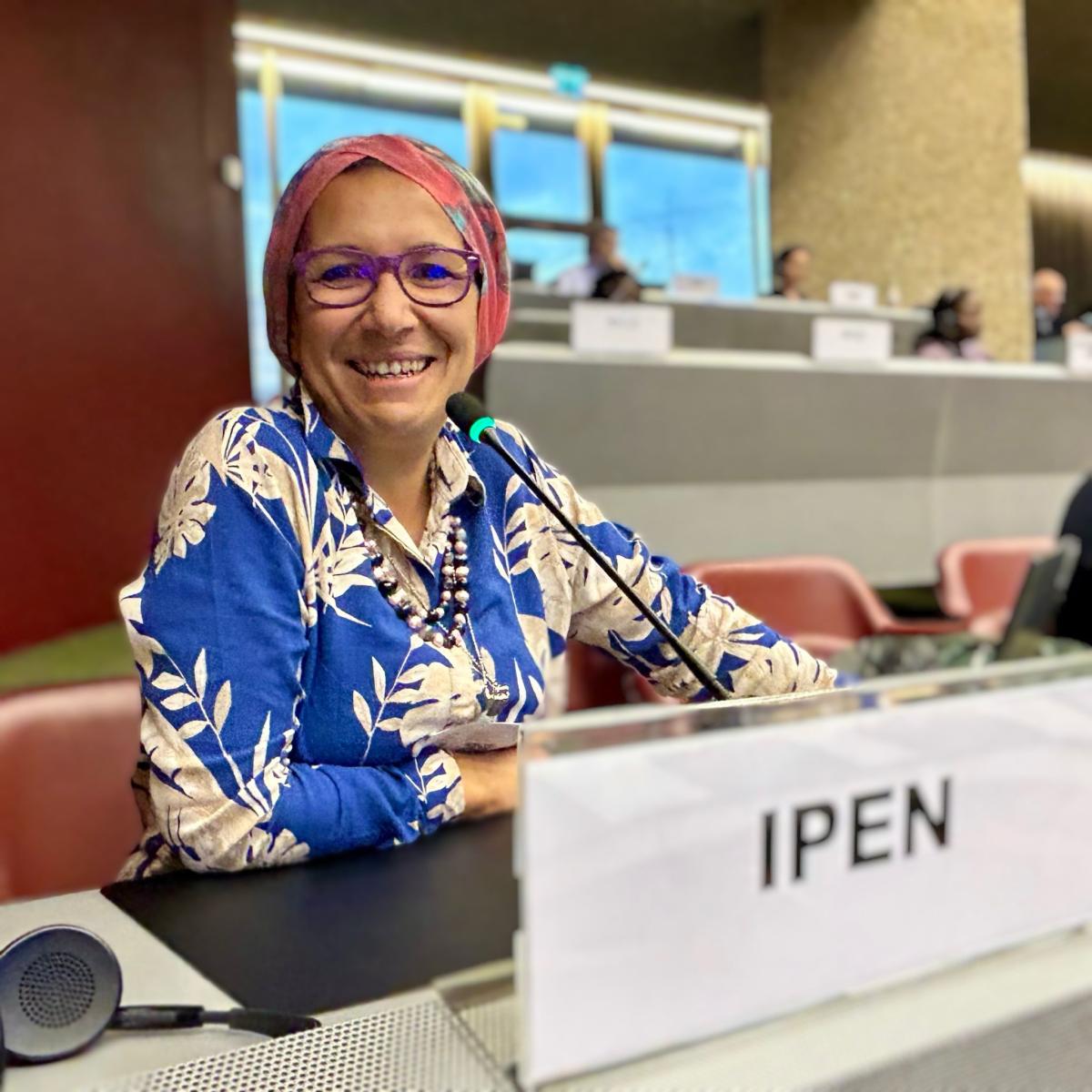
Thank you, Madame President.
I give this closing statement on behalf of IPEN, a network of more than 600 public interest NGOs in over 120 countries working for a toxics-free future.
Since the mercury treaty was adopted 10 years ago, much progress has been accomplished with the support of all stakeholders. At COP5, several important decisions have been made which provide a good basis for the next 10 years. But soon, we would like to see strong actions by parties to end mercury trade globally, set a firm date to end the "use allowed" provision for ASGM under Article 2, and intensify health-related activities to address mercury poisoning.
The waste threshold decision, while celebrated by some for achieving any outcome on the issue, is really quite problematic if we are to be honest with ourselves. While the 15 mg/kg threshold is workable, if somewhat high, the opt out clause, where any country can use any threshold or definition they choose, undermines global harmonisation on this issue and opens the door to transboundary exploitation. It is clear that such loopholes are not all addressed under the Basel Convention.
On a more positive note, we welcome the forthcoming cooperation and collaboration between the Minamata Convention Secretariat with the Montreal- Kunming Global Biodiversity Framework which will provide a new avenue to address the urgent issue of contaminated sites.
IPEN looks forward to COP 6 and a far more ambitious agenda that refocuses our attention on the core convention issues of human health and mercury pollution.
Thank you, Madame President.
